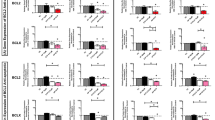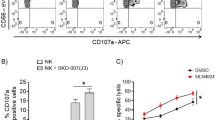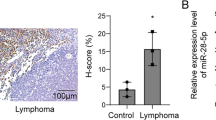Abstract
The peroxisome proliferator-activated receptor γ (PPAR γ), a member of the nuclear receptor superfamily, is expressed at highest levels in adipose tissue and functions as a central regulator in the process of adipocyte differentiation. In the present study, we showed that human leukemic cell lines, not only myeloid but also lymphoid, express PPAR γ and its activation by natural ligand (15-deoxy-Δ12,14 - prostaglandin J2) and synthetic ligand (troglitazone) profoundly inhibited their proliferation by induction of apoptosis preferentially in the serum-free culture. We pursued its mechanism using the representative cell lines, and found that induction of apoptosis was accompanied by caspase-3 activation and specifically blocked by its inhibitor. While status of several apoptosis-related molecules remained unchanged, the c-Myc expression was markedly down-regulated within 24 h after troglitazone treatment. The c-myc mRNA levels were dramatically reduced at 1 h and became undetectable at 12 h after troglitazone treatment, which proved to be accompanied by complete blockade of the Tcf-4 activity in the electrophoretic mobility shift assay. We succeeded in establishing HL-60 cell lines growing well in the presence of troglitazone in the long-term serum-free culture. They showed neither induction of apoptosis nor down-regulation of the c-Myc expression via blockade of the Tcf-4 activity after troglitazone treatment. This is the first identification of the linkage between PPAR γ-mediated apoptosis and down-regulation of the c-myc gene expression.
Similar content being viewed by others
Log in or create a free account to read this content
Gain free access to this article, as well as selected content from this journal and more on nature.com
or
Abbreviations
- PPAR:
-
peroxisome proliferator-activated receptor
- Tcf-4:
-
T cell factor-4
- APC:
-
adenomatous polyposis coli
- FCS:
-
fetal calf serum
- EMSA:
-
electrophoretic mobility shift assay
- ECL:
-
enhanced chemiluminescence
References
Mangelsdorf DJ, Thummel C, Beato M, Herrlich P, Schutz G, Umesono K, Blumberg B, Kastner P, Mark M, Chambon P, Evans RM . 1995 The nuclear receptor superfamily: the second decade Cell 83: 835–839
Braissant O, Foufelle F, Scotto C, Dauca M, Wahli W . 1996 Differential expression of peroxisome proliferator activated receptors (PPARs): tissue distribution of PPAR-α, -β, and -γ in adult rat Endocrinology 137: 354–366
Kliewer SA, Forman BM, Blumberg B, Ong ES, Borgmeyer U, Mangelsdorf DJ, Umesomo K, Evans RM . 1994 Differential expression and activation of a family of murine peroxisome proliferator activated receptors Proc. Natl. Acad. Sci. U.S.A. 91: 7355–7359
Lemberger T, Desvergne B, Wahli W . 1996 Peroxisome proliferator-activated receptors: a nuclear receptor signaling pathway in lipid physiology Annu. Rev. Cell Dev. Biol. 12: 335–363
Wahli W, Braissant O, Desvergne B . 1995 Peroxisome proliferator-activated receptors: transcriptional regulator of adipogenesis, lipid metabolism and more Chem. Biol. 2: 261–266
Spiegelman BM, Flier JS . 1996 Adipogenesis and obesity: rounding out the big picture Cell 87: 377–389
Kliewer SA, Lenhard JM, Willson TM, Patel I, Morris DC, Lehmann JM . 1995 A prostaglandin J2 metabolite binds peroxisome proliferator activated receptor and promotes adipocyte differentiation Cell 83: 813–819
Kliewer SA, Umesono K, Noonan DJ, Daniel J, Heyman RA, Evans RM . 1992 Convergence of 9-cis retinoic acid and peroxisome proliferator signalling pathways through heterodimer formation of their receptors Nature 358: 771–774
Dreyer C, Krey G, Keller H, Givel F, Helftenbein G, Wahli W . 1992 Control of the peroxisomal β-oxidation pathway by a novel family of nuclear hormone receptors Cell 68: 879–887
Ijpenberg A, Jeannin E, Wahli W, Desvergne B . 1997 Polarity and specific sequence requirements of peroxisome proliferator-activated receptor (PPAR)/retinoid X receptor heterodimer binding to DNA J. Biol. Chem. 272: 20108–20117
Forman BM, Tontonoz P, Chen J, Brun RP, Spiegelman BM, Evans RM . 1995 15-Deoxy-Δ12,14-prostaglandin J2 is a ligand for the adipocyte determination factor PPAR γ Cell 83: 803–812
Lehmann JM, Moore LB, Smith-Oliver TA, Willson WO, Wilson TM, Kliewer SA . 1995 An antidiabetic thiazolidinedione is a high affinity ligand for peroxisome-proliferated receptor γ (PPAR γ) J. Biol. Chem. 270: 12953–12956
Iwamoto Y, Kuzuya T, Matsuda A, Awata T, Kumakura S, Inooka G, Shiraishi I . 1991 Effect of new oral antidiabetic agent CS-045 on glucose tolerance and insulin secretion in patients with NIDDM Diabetes 14: 1083–1086
Jiang C, Ting AT, Seed B . 1998 PPAR γ agonists inhibit production of monocyte inflammatory cytokines Nature 391: 82–86
Ricote M, Li AC, Willson TM, Kelly CJ, Glass CK . 1998 The peroxisome proliferator-activated receptor-γ is a negative regulator of macrophage Nature 391: 79–82
Auboeuf D, Rieusset J, Fajas L, Vallier P, Frering V, Riou JP, Staels B, Auwerx J, Laville M, Vidal H . 1997 Tissue distribution and quantification of the expression of mRNAs of peroxisome proliferator-activated receptors and liver X receptor-alpha in humans: no alteration in adipose tissue of obese and NIDDM patients Diabetes 46: 1319–1327
Sarraf P, Mueller E, Jones D, King FJ, Deangelo DJ, Partridge JB, Holden SA, Chen LB, Singeer S, Fletcher C, Spiegelman BM . 1998 Differentiation and reversal of malignant changes in colon cancer through PPAR γ Nature Med. 4: 1046–1052
Brian S . 1998 PPAR γ and colorectal carcinoma: conflicts in a nuclear family Nature Med. 4: 1004–1005
Saez E, Tontonoz P, Nelson MC, Alvarez JG, Ming UT, Baird SM, Thomazy VA, Evans RM . 1998 Activators of the nuclear receptor PPAR γ enhance polyp formation Nature Med. 4: 1058–1061
Lefebvre AM, Chen I, Dereumaux P, Najib J, Fruchart JC, Geboes K, Briggs M, Heyman R, Auwerx J . 1998 Activation of the peroxisome proliferator-activated receptor γ promotes the development of colon tumors Nature Med. 4: 1053–1057
Spiegelman BM . 1998 PPAR γ in monocytes: less pain, any gain? Cell 93: 153–155
Green ME, Blumberg B, McBride OW, Yi HF, Kronquist K, Kwan K, Hsieh L, Green G, Nimer SD . 1995 Isolation of the human peroxisome proliferator-activated receptor gamma cDNA: expression in hematopoietic cells and chromosomal mapping Gene Expr. 4: 281–299
Sugiura A, Kiriyama Y, Nochi H, Tsuchiya H, Tamoto K, Sakurada Y, Ui M, Tokumitsu Y . 1999 Troglitazone suppresses cell growth of myeloid leukemia cell lines by induction of p21 WAF1/CIP1 cyclin-dependent kinase inhibitor Biochem. Biophys. Res. Commun. 261: 833–837
Tontonoz P, Nagy L, Alvarez JGA, Thomazy V, Evans RM . 1998 PPAR γ promotes monocyte/macrophage differentiation and uptake of oxidized LDL Cell 93: 241–252
Hirase N, Yanase T, Mu Y, Muta K, Umemura T, Takayanagi R, Nawata H . 1999 Thiazolidinedione induces apoptosis and monocytic differentiation in the promyelocytic leukemia cell line HL60 Oncology 57: 17–26
Chang T, Szabo E . 2000 Induction of differentiation and apoptosis by ligands of peroxisome proliferator-activated receptor γ in non-small cell lung cancer Cancer Res. 60: 1129–1138
Sato H, Ishihara S, Kawashima K, Moriyama N, Suetsugu H, Kazumori H, Okuyama T, Rumi MA, Fukuda R, Nagasue N, Kinoshita Y . 2000 Expression of peroxisome proliferator-activated receptor (PPAR γ) in gastric cancer and inhibitory effects of PPAR γ agonists Br. J. Cancer 83: 1394–1400
Jeffrey AK, Timothy AS, Keith WM, Janine LR, Stewart G, Murray DM . 1999 15-Deoxy-Δ12,14-prostaglandin J2, a ligand for peroxisome proliferator-activated receptor γ, induces apoptosis in JEG3 choriocarcinoma cells Biochem. Biophys. Res. Commun. 262: 579–585
Adams M, Montague CT, Prince JB, Holder JC, Smith SA, Sanders L, Digby JE, Sewter CP, Lazar MA, Chatterjee VK, O'Rahilly S . 1997 Activation of peroxisome proliferator-activated receptor γ have depot-specific effects on human preadipocyte differentiation J. Clin. Invest. 100: 3149–3153
Shao D, Lazar MA . 1997 Peroxisome proliferator activated receptor γ, CCAAT/enhancer-binding protein α, and cell cycle status regulate the commitment to adipocyte differentiation J. Biol. Chem. 272: 21473–21478
Ristow M, Muller-Wieland D, Pfeiffer A, Krone W, Kahn CR . 1998 Obesity associated with a mutation in a genetic regulator of adipocyte differentiation N. Engl. J. Med. 339: 953–959
Hu E, Kim JB, Sarraf P, Spiegelman BM . 1996 Inhibition of adipogenesis through MAP kinase-mediated phosphorylation of PPARγ Science 274: 2100–2103
Li P, Nijhawan D, Budihardjo I, Srinivasula SM, Ahmad M, Alnemri ES, Wang X . 1997 Cytochrome c and dATP-dependent formation of Apaf-1/Caspase-9 complex initiates an apoptotic protease cascade Cell 91: 479–489
Reed JC . 1997 Cytochrome c: Can't live with it- Can't live without it Cell 91: 559–562
Scaffidi C, Fulda S, Srinivasan A, Friesen C, Li F, Tomaselli KJ, Debatin KM, Krammer PH, Peter ME . 1998 Two CD95 (APO-1/Fas) signaling pathways EMBO J. 17: 1675–1687
Holtz-Heppelmann CJ, Algeciras A, Badley AD, Paya CV . 1998 Transcriptional regulation of the human FasL promoter-enhancer region J. Biol. Chem. 273: 4416–4423
Miyasita T, Reed JC . 1995 Tumor suppressor p53 is a direct transcriptional activator of the human bax gene Cell 80: 293–299
Raingeaud J, Gupta S, Rogers JS, Dickens M, Han J, Ulevitch RJ, Davis RJ . 1998 Pro-inflammatory cytokines and environmental stress cause p38 mitogen-activated protein kinase activation by dual phosphorylation on tyrosine and threonine J. Biol. Chem. 273: 4416–4423
Davis RJ . 1994 MAPKs: new JNK expands the group Trends. Biochem. Sci. 19: 470–473
Xia Z, Dickens M, Raingeaud J, Davis RJ, Greenberg ME . 1995 Opposing effects of ERK and JNK-p38 MAP kinases on apoptosis Science 270: 1326–1331
Johnson NL, Gardner AM, Diener KM, Carol A, Carter L, Gleavy J, Jarpe MB, Minden A, Karin M, Zon LI, Johnson GL . 1996 Signal transduction pathways regulated by mitogen-activated/extracellular response kinase kinase kinase induce cell death J. Biol. Chem. 271: 3229–3237
Huang S, Jiang Y, Li Z, Nishida E, Mathias P, Lin S, Ulevitch RJ, Nemerow GR, Han J . 1997 Apoptosis signaling pathway in T cells is composed of ICE/Ced-3 family proteases and MAP kinase kinase 6b Immunity 6: 739–749
Kangas A, Nicholson DW, Holtta E . 1998 Involvement of CPP32/Caspase-3 in c-Myc-induced apoptosis Oncogene 16: 387–398
Wu M, Arsura M, Bellas RE, Fitzgerald MJ, Lee H, Schauer SL, Sherr DH, Sonenshein GE . 1996 Inhibition of c-myc expression induces apoptosis of WEHI 231 murine B cells Mol. Cell. Biol. 16: 5015–5025
Duyao MP, Buckler AJ, Sonenshein GE . 1990 Interaction of an NF-κB-like factor with a site upstream of the c-myc promoter Proc. Natl. Acad. Sci. U.S.A. 87: 4727–4731
Scheinman RI, Gualberto A, Jewell CM, Cidlowsi JA, Baldwin AS . 1995 Characterization of mechanisms involved in transrepression of NF-κB by activated glucocorticoid receptors Mol. Cell. Biol. 15: 943–953
Wang Y, Jhang JJ, Dai W, Lei KY, Pike JW . 1997 Dexamethasone potently enhances phorbol ester-induced IL-1β gene and nuclear factor NF-κB activation J. Immunol. 159: 534–537
He TC, Sparks AB, Rago C, Hermeking H, Zawel L, da Costa LT, Morin PJ, Vogelstein B, Kinzler KW . 1998 Identification of c-Myc as a target of the APC pathway Science 281: 1509–1512
Henriksson M, Luscher B . 1996 Proteins of the Myc network: essential regulators of cell growth and differentiation Adv. Cancer Res. 68: 109–182
Kretzner L, Blackwood EM, Eisenman RN . 1992 Myc and Max proteins possess distinct transcriptional activities Nature 359: 426–429
Askew DS, Ashmun RA, Simmons BC, Cleveland JL . 1991 Constitutive c-myc expression in an IL-3-dependent myeloid cell line suppressed cell cycle arrest and accelerates apoptosis Oncogene 6: 1915–1922
Evan GI, Wyllie AH, Gilbert CS, Littlewood TD, Land H, Brooks M, Waters CM, Penn LZ, Hancock DC . 1992 Induction of apoptosis in fibroblasts by c-myc protein Cell 69: 119–128
Shi Y, Glynn JM, Guilbert LJ, Cotter TG, Bissonnette RP, Green DR . 1992 Role of c-myc in activation-induced apoptotic cell death in T cell hybridomas Science 257: 212–214
Thulasi R, Harbour D, Thompson EB . 1993 Suppression of c-myc is a critical step in glucocorticoid-induced human leukemic cell lysis J. Biol. Chem. 268: 18306–18312
Kimura S, Maekawa T, Hirakawa K, Murakami A, Abe T . 1995 Alterations of c-myc expression by antisense oligodeoxynucleotides enhance the induction of apoptosis in HL-60 cells Cancer Res. 55: 1379–1384
Helmberg A, Auphan N, Caelles C, Karin M . 1995 Glucocorticoid-induced apoptosis of human leukemic cells is caused by the repressive function of the glucocorticoid receptor EMBO J. 14: 452–460
Chinetti G, Griglio S, Antonucci M, Torra IP, Delerive P, Majd Z, Fruchart JC, Chapman J, Najib J, Staels B . 1998 Activation of proliferator-activated receptors α and γ induces apoptosis of human monocyte-derived macrophages J. Biol. Chem. 273: 25573–25580
Zhang MY, Sun SC, Bell L, Miller BA . 1998 NF-κB transcription factors are involved in normal erythropoiesis Blood 91: 4136–4144
Korinek V, Barker N, Morin PJ, Wichen D, Weger R, Kinzler KW, Vogelstein B, Clevers H . 1996 Constitutive transcriptional activation by a β-catenin-Tcf complex in APC−/− colon carcinoma Science 275: 1784–1787
Kubota T, Koshizuka K, Williamson EA, Asou H, Said JW, Holden S, Miyoshi I, Koffler HP . 1998 Ligand for peroxisome proliferator-activated receptor γ (troglitazone) has potent antitumor effect against human prostate cancer both in vitro and in vivo Cancer Res. 58: 3344–3352
Xin X, Yang S, Kowalski J, Gerritsen ME . 1999 Peroxisome proliferator-activated receptor-γ ligands are potent inhibitors of angiogenesis in vitro and in vivo J. Biol. Chem. 274: 9116–9121
McGehee RE, Ron D, Brasier AR, Habener JF . 1993 Differentiation-specific element: a cis-acting developmental switch required for the sustained transcriptional expression of the angiotensinogen gene during hormonal-induced differentiation of 3T3-L1 fibroblasts to adipocytes Mol. Endocrinol. 7: 551–560
Barker N, Huls G, Korinek V, Clevers H . 1999 Restricted high level expression of Tcf-4 protein in intestinal and mammary gland epithelium Am. J. Pathol. 154: 29–35
Fujiwara T, Yoshioka S, Yoshioka T, Ushiyama I, Horikoshi H . 1988 Characterization of new oral antidiabetic agent CS-045. Studies in KK and ob/ob mice and zucker fatty rats Diabetes 37: 1549–1558
Kojika S, Sugita K, Inukai T, Saito M, Iijima K, Tezuka T, Goi K, Shiraishi K, Mori T, Okazaki T, Kagami K, Ohyama K, Nakazawa S . 1996 Mechanisms of glucocorticoid resistance in human leukemic cells; implication of abnormal 90 and 70 kDa heat shock proteins Leukemia 10: 994–999
Inukai T, Inaba T, Yoshihara T, Look AT . 1997 Cell transformation mediated by homodimeric E2A-HLF transcription factors Mol. Cell. Biol. 17: 1417–1424
Author information
Authors and Affiliations
Corresponding author
Additional information
Edited by M Naito
Rights and permissions
About this article
Cite this article
Yamakawa-Karakida, N., Sugita, K., Inukai, T. et al. Ligand activation of peroxisome proliferator-activated receptor γ induces apoptosis of leukemia cells by down-regulating the c-myc gene expression via blockade of the Tcf-4 activity. Cell Death Differ 9, 513–526 (2002). https://doi.org/10.1038/sj.cdd.4401000
Received:
Revised:
Accepted:
Published:
Issue date:
DOI: https://doi.org/10.1038/sj.cdd.4401000
Keywords
This article is cited by
-
Identifying Genetic Signatures Associated with Oncogene-Induced Replication Stress in Osteosarcoma and Screening for Potential Targeted Drugs
Biochemical Genetics (2024)
-
T cell factor-4 functions as a co-activator to promote NF-κB-dependent MMP-15 expression in lung carcinoma cells
Scientific Reports (2016)
-
Expression of Peroxisome Proliferator Activated Receptor-Gamma (PPAR-γ) in Human Non-small Cell Lung Carcinoma: Correlation with Clinicopathological Parameters, Proliferation and Apoptosis Related Molecules and Patients’ Survival
Pathology & Oncology Research (2012)
-
Transcription profiling of lung adenocarcinomas of c-myc-transgenic mice: Identification of the c-myc regulatory gene network
BMC Systems Biology (2008)
-
Ciglitazone Induces Caspase-Independent Apoptosis through Down-Regulation of XIAP and Survivin in Human Glioma Cells
Neurochemical Research (2008)



